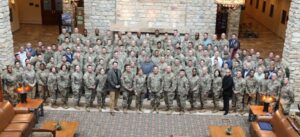
Story by Kirk Frady
Medical Readiness Command, Europe
GARMISCH, Germany – U.S. Army medical planners, logisticians, and providers from across Europe and Africa took part in a four-day Strategic Health Readiness Symposium in Garmisch, Germany March 18-21. The symposium was one of several annual events designed to focus on Army medical operations and support for the warfighter.
The host for the four-day workshop was Brig. Gen. Roger Giraud, command surgeon for U.S. Army Europe and Africa. Giraud is also commander of Medical Readiness Command, Europe and director of Defense Health Network Europe.
“The overall goal of the Strategic Health Readiness Symposium was to ensure that our medical forces, both operating and generating, remain ready and postured to support the warfighter if war should ever occur,” said Giraud. “We must be ready to answer the call across all phases and we must ensure our resources are aligned. We must also ensure that our plans are synchronized and integrated so that we deliver the best medical care possible to our service members.”
Throughout its two-hundred and forty-plus year history, U.S. Army medical forces have provided comfort, strength, and compassion to the wounded, ill and injured.
“Our Army medical forces have been conserving the fighting strength since 1775, ensuring that we maintain capable combat forces,” added Giraud. “The Soldiers we support depend on us to make the right decisions. As such, we must ensure that our medical Soldiers are trained to the highest level. Our warfighters deserve the very best care possible and that is non-negotiable.”
The guest speaker for the symposium was Maj. Gen. Paula Lodi, commander of the 18th Theater Medical Command (Deployment Support) located at Fort Shafter, Hawaii. During her presentation, Lodi shared her insights, and lessons learned on theater level medical operations and support to the warfighting force in the Pacific Theater of operations.
“We are all one big Army medicine family, and we’re all invested in the success of supporting our warfighters,” said Lodi. “Running a theater medical command is a complex operation. The ability to perform as a theater medical command, and to truly synchronize and integrate medical support, really takes bringing together your joint partners, your combined partners, your allies, and the total military medical community. It is truly a team effort.”
As with any major military operation, regardless of the type or location, it always requires extensive planning, rehearsals, coordination, and preparation. The same goes for military medical operations.
“Medical support to the warfighter is complicated work,” said Col. (Dr.) Ross Witters, deputy command surgeon for U.S. Army Europe and Africa. “We simply can’t focus on every component of our medical health support system in any single training venue or exercise. So, during this week’s Strategic Health Readiness Symposium we all came together to analyze and identify new areas for improvement based upon recent lessons learned from exercises such as Defender and current support operations. This allows us to develop requirements and future training that will improve our effectiveness to support health care, save lives on the battlefield, and build readiness across the entire medical force.”
Symposium participants also had the opportunity to hear from Brig. Gen. Andrew Landers, commander of the recently formed 68th Theater Medical Command, a U.S. Army Europe and Africa command operational medical asset. Landers provided attendees an overview of the 68th Theater Medical Command (TMC), its structure, and some of the challenges they faced during its initial establishment.
“We see ourselves an integrator, synchronizing care across Europe and Africa.” said Landers about the 68th TMC. “As a collective military medicine team, we need to understand each other’s challenges and opportunities. But most importantly, we need to get to know every one of you in this room. Because at the end of the day, when things go bad, it’s all about relationships and who you know.”
In addition to forging closer working relations among the participants, the four-day medical symposium provided the opportunity for U.S. Army medical planners and logisticians to synchronize their efforts regarding medical planning, theater mission assets, and other medical operations within the European and African theaters of operation.
“The Soldiers we support depend on us to make the right decisions,” said Giraud. “As I told everyone here, that Red Cross we wear is a symbol of strength for our Soldiers. That Soldier knows that if he, or she, becomes wounded, ill, or injured, we will take care of them. We give them hope.”
As the Army’s only forward stationed medical readiness command, Medical Readiness Command, Europe provides sustained health services in support of forces in U.S. Army Europe and Africa and United States Army Central to enable readiness and conserve the fighting strength. This mission is accomplished by MRC,EUR personnel assigned across Europe, Africa, and Central Asia, 24 hours a day, 365 days a year.